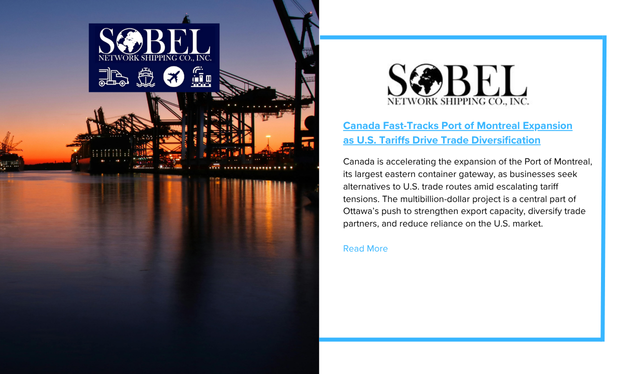Canada is accelerating the expansion of the Port of Montreal, its largest eastern container gateway, as businesses seek alternatives to U.S. trade routes amid escalating tariff tensions. The multibillion-dollar project is a central part of Ottawa’s push to strengthen export capacity, diversify trade partners, and reduce reliance on the U.S. market.
The C$1.6 billion (US$1.15 billion) expansion — identified by the federal government as a project of national importance — will add a new container terminal at Contrecoeur, 30 miles northeast of Montreal. The project will expand the port’s handling capacity by more than 50%, enabling it to manage up to 1.15 million additional containers annually once operations begin around 2030.
Diversifying Beyond the U.S. Market
Roughly 80% of Canadian exports currently flow to the United States. However, with U.S. tariffs reshaping trade patterns, Canadian exporters are looking to Europe, the Middle East, and Asia to establish new market footholds.
“Canada’s trade strategy is evolving from a north-south orientation to a global one,” said port officials. “This expansion will help build maritime resilience and improve access to overseas markets.”
A recent national survey found that more than half of Canadian exporters expect U.S. tariffs to negatively impact their business, while nearly a quarter plan to target new customers outside the U.S.
Overcoming Operational Challenges
While Montreal remains a key logistics hub serving Quebec, Ontario, and the U.S. Midwest, capacity constraints and past labor disruptions have hindered its growth. The port’s location along the St. Lawrence River—with a navigational depth of about 37 feet—limits the size of vessels that can call fully loaded, compared to deeper East Coast ports such as Halifax and Saint John.
Despite these challenges, port officials say newer containership designs and infrastructure upgrades will allow modern vessels to operate at higher utilization rates.
Investment and Partnerships
The project is being developed in partnership with DP World, the global terminal operator that also manages the Port of Saint John. The expansion will include new berths, truck gates, container yards, and rail links connecting Montreal with inland industrial centers.
DP World’s increased footprint in Canada reflects a broader trend of international terminal operators investing in North American infrastructure amid shifting global supply chains. Its Canadian operations are partially owned by Quebec’s Caisse de dépôt et placement du Québec, a major pension fund.
Officials note that if just 6% of Canadian exports currently routed through the U.S. shift to Montreal, the port could reach full capacity, underscoring the urgency of the expansion.
Strategic Implications
The move highlights Canada’s strategy to adapt to global trade realignments triggered by the ongoing U.S. tariff regime. By accelerating key infrastructure projects and enhancing maritime connectivity, Canada aims to strengthen its position as a competitive North American logistics hub capable of serving both transatlantic and transpacific trade flows.


